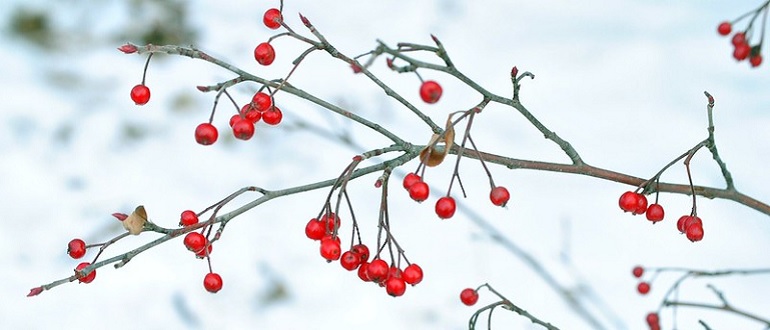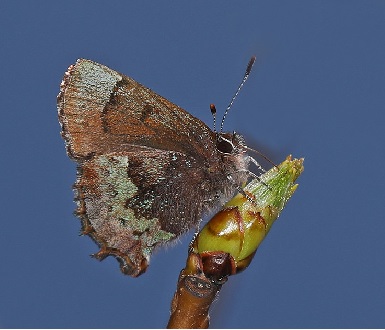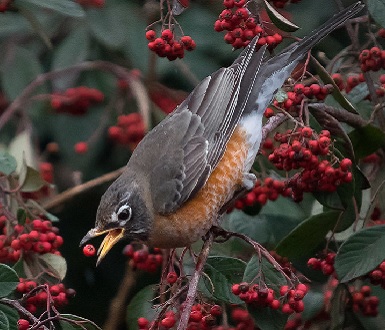Winterberry
One of the prettiest plants in the winter landscape is the winterberry shrub. A member of the holly family, winterberry offers an abundance of brilliant red berries that last throughout the dreary months of winter, brighten up the bleak landscape, and offer a welcome buffet for birds.
FUN FACT on Berry Nutrition: There are many species of berries, and they vary greatly in regard to seasonal growth patterns and nutritional value. Interestingly, the nutritional content of berries appears to strongly correspond to the season of berry development and to the relative needs of local birds during that season. Therefore, spring/summer berries tend to be higher in protein and carbohydrates that aids in the growth of young fledglings while fall and winter berries tend to have higher fat content that helps sustain birds through migrations and cold temperatures. Per information from Cornell University & The Nature Conservancy, the dull, tan colored berries of poison ivy actually offer some of the highest fat content of all for fall migrating birds.
Native winterberry shrubs are also a host plant for the Henry’s elfin butterfly. This tiny butterfly prefers the leaves and flowers of various native shrubs in both its caterpillar stage and its adult butterfly stage.
Historically, this shrub was a common understory plant throughout the mixed forests, wetlands, and streambanks of southeast Michigan. Because winterberries are a type of persistent berry, the berries do not easily drop from the plant. Instead, the berries hang on after ripening, and remain available to wildlife well into the winter season.
Additionally, the sugars within winterberries only start developing a sweetness after experiencing several hard frosts. Thereby, mother nature preserves these wonderful berries throughout the fall and serves them up – fresh and tasty (for birds) – during the coldest days of winter.
It must be noted that the winterberry shrub (berries, leaves, stems, and even roots), is toxic to humans and other large mammals including the family dog. Deer also find the plant unpalatable, making this a good choice for areas that are overgrazed by our growing deer population. So, while this shrub might not be suited to the small suburban yards of young families, the winterberry is a fine landscaping option for large, naturalized areas. Additionally, winterberry’s affinity for wetland soils makes it well suited for large rain garden projects that help reduce storm run-off and stream pollution.
PLANT SPECIFICATIONS
Winterberry is a deciduous, native shrub that prefers wetland areas with damp, acidic soil. In ideal conditions, this shrub may grow to fifteen feet tall and, due to extensive underground root suckers, may also develop into a dense thicket. For most of the year, native winterberry shrubs have an unremarkable appearance. Summer foliage is medium green, and there is generally little color change in fall. Likewise, winterberry’s springtime flowers are small, whitish, and fairly well hidden among the leaves. It is only during winter, when the bright berries shine against bare branches – that winterberry becomes a landscape star.
Cautionary Note: In order for winterberry shrubs to bear fruit, it is necessary to have a matched pair (male and female plant of the same strain ) that are planted in close proximity.
Winterberry is a dioecious type of shrub. Individual plants are either specifically female or male, and therefore produce different flower types. Only female plants can develop berries, and that is only if the female flowers have been fertilized from an appropriate flowering male plant. (Thank you bees and butterflies!) Additionally, the pair must be matched for both type and bloom time. Flowers of compatible female and male cultivars must bloom at the same time for effective pollination. Unmatched pairs are unlikely to result in proper pollination and berries.
And while the nursery industry has developed a variety of winterberry cultivars, FOTR recommends planting true “wild type native strains” in order to achieve maximum environmental benefit. Unfortunately, cultivars often prioritize visual characteristics valued by humans rather than characteristics needed by wildlife. Therefore, cultivars might produce beautiful berries, but not necessarily beneficial berries. Garden pros also indicate that plant maturity and seasonal weather patterns may affect the apparent tastiness (for birds) of various berries from year to year.
TAKE ACTION
Native plants that offer year-round shelter and food for wildlife are essential for maintaining populations of both our migratory and year-round bird residents. Additionally, wetland plants with deep root systems for absorbing storm run-off are essential to the overall health of our rivers, streams, and drinking water. You can help FOTR work to protect and restore our wetlands and native plant communities by planting rain gardens, pollinator gardens, native plants and shrubs. You can also help by avoiding pesticide use and practicing healthy lawn care, and by joining in our annual Rouge River clean-up projects.
MAIN PHOTO CREDIT: Winterberry (Ilex verticillata) – by David Guthrie CC-BY-SA-2.0 – image cropped


